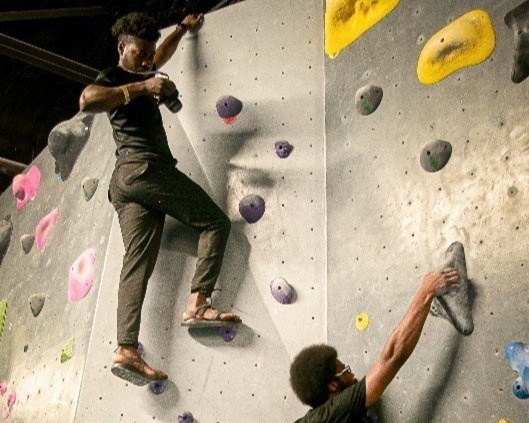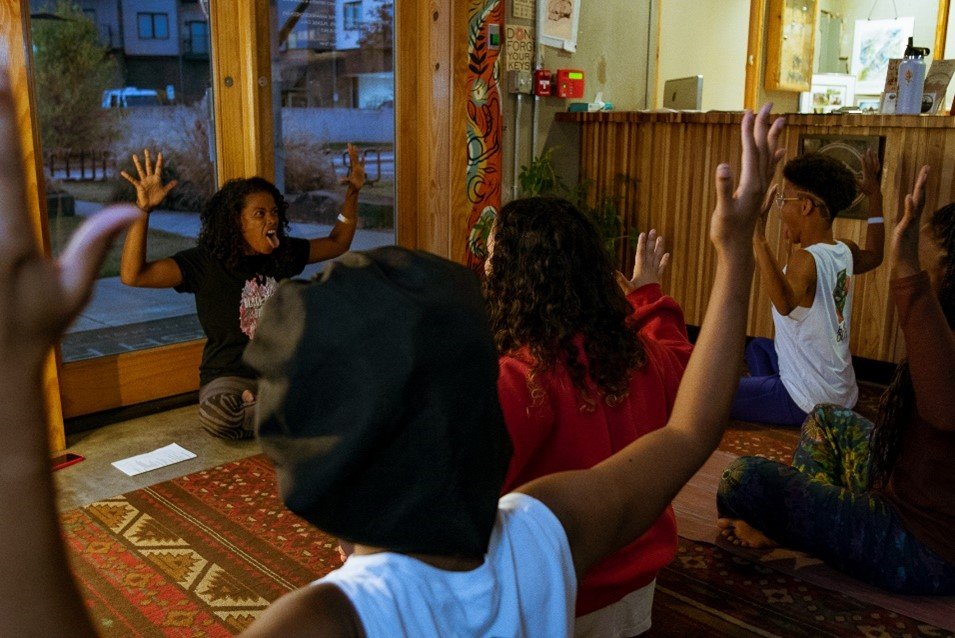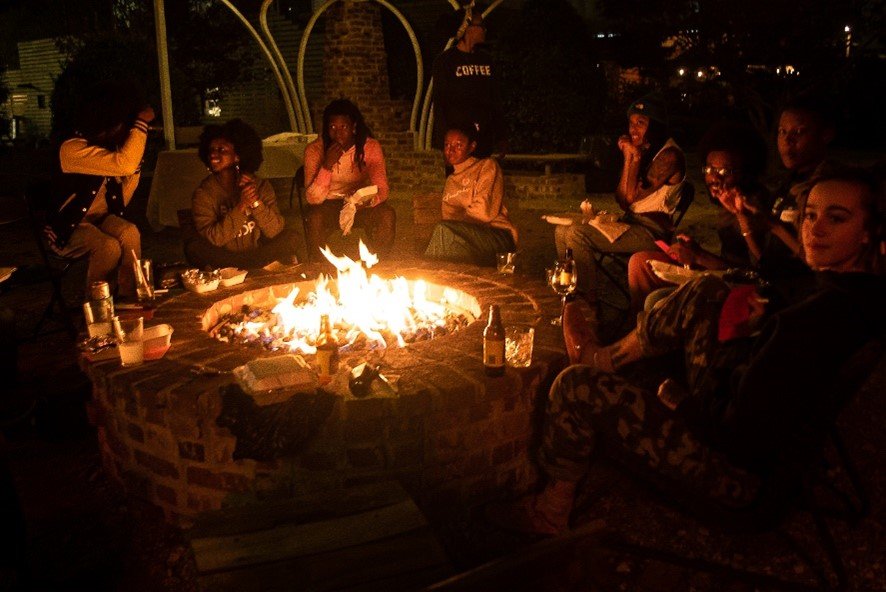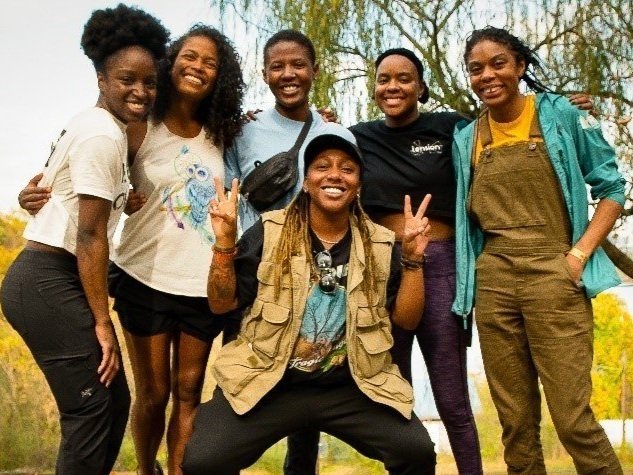In June 2020, I met with city officials in College Park, GA about their desire to bring rock climbing to their city. Many of them had heard of my story and my newly founded nonprofit organization, Climbing for Change (C4C), and believed I could inspire their community and offer new opportunities for College Park. Their enthusiasm motivated me to partner with 1Climb to secure a $100,000 donation from Adidas; this donation would go towards building a climbing wall in the Tracy Wyatt Recreation Center (TWRC) in the heart of College Park. Adidas also provided an assortment of rental climbing shoes and harnesses for community use. Once we brought this idea to Stone Summit Climbing, a major climbing gym chain in the Atlanta area, they were eager to partner with C4C and establish contracts to help cover wall maintenance costs and assist with community programming. This partnership included covering the $3,000 annual service fee for the auto-belays, routinely resetting the climbing wall, providing assistance with organizing clinics and a climbing club, in addition to providing reduced or free passes to climb at their commercial facilities. Despite Covid delays and continued social distancing protocols, our collective work and dedication helped this project move faster than expected; by Fall 2021, the climbing wall was open, with the first year having limited public use for health/safety reasons. With the help of our partners, we were able to donate this wall and create this program at no cost to the city; the only recurring cost moving forward being a $34 annual bill for insurance.
Between 2021 and 2024, I stayed in communication with the TWRC director to assist with programming and maintaining the wall. During this period, we only heard glowing responses from the officials and the community. In 2.5 years, the wall had been visited 15,000 times and was used as a resource for camps, classes, and holiday events. Based on the comradery and appreciation we’ve received from the city, it is still unclear why the city council suddenly made a decision that will likely lead to the removal of this wall.
Below is a timeline of events that have led us to this point:
Late Febrary, Councilwoman Arnold toured the Tracey Wyatt Recreation Center.
During the March 4th city council meeting, Arnold was very complimentary of the TWRC and it’s staff.
On April 5th, I was cc'ed on an email from Michelle Johnson (the director of Parks and Recreation) requesting a quote and guidance for removing and possibly relocating the wall to a different location. I responded and asked why and whether there were any safety issues. Ms. Johnson responded and said she would defer to the city manager, Dr. Adediran, for the reason for the request.
On April 8th, the wall manufacturer, Eldorado Climbing, responded and advised against removing and trying to relocate the wall to a different location. This warning was "due to the semi-destructive nature of the removal process and the engineering/design work that would be required to achieve this". They insisted that the cost of building a new wall would be a comparable and preferred option. I later spoke with the company to understand their concerns and costs.
On April 9th, at 10:21am, I wrote an email to Dr. Adediran and cc'ed the mayor and the entire city council. I asked about the reason for removing the wall and inquired about whether there were safety concerns. I also reiterated the reasons why I originally donated the wall and the potential impact of exposing kids to this new sport. Dr. Adediran later responded and said that no safety issues or injuries had been reported. He did not have an answer regarding the reason for the removal of the wall.
On April 9th at 2:47pm, Councilwoman Arnold sent an email to the city manager, Dr. Adediran, asking him to "Please inform your staff that the removal of the rock climbing wall is not up for debate or discussion. Please have it removed immediately. "
On April 9th at 3:05 pm, Dr. Adediran sent an email to Michelle Johnson telling her that "the instructions to you was to contact the company and remove wall."
On April 10th, councilwoman Arnold sent an email to Michelle Johnson (the director of Parks and Recreation) and asked her for a lot of data regarding the rockwall.
On April 11th, Michelle Johnson sent an email responding to Arnold’s questions.
Residents were quickly made aware of the city's intent to remove the climbing wall and started a website, collegeparkrocks.com, to bring awareness to the residents’ concerns about losing their rock wall. There has since been overwhelming support for preserving the rock wall.
On April 15th, I attended College Park’s city council meeting and expressed my concern about the city discarding our $100,000 donation without providing any rationale. I once again asked for answers to why this decision was happening; none of the council members made any comments or responses regarding the removal of the rock wall.
The issue of the rock wall removal was eventually added to the May 6th agenda for the city council meeting.
On May 5th, I personally called and spoke with councilman Gay and councilwoman McKenzie about the next day’s vote on the wall. McKenzie told me the residents of her ward had expressed overwhelming support for keeping it intact. Both assured me that they were in support of keeping and maintaining the rock wall. They both also acknowledged they have not been consulted or given any reasons for the decision to remove the wall.
On May 6, at the city council meeting, Arnold gave a statement regarding her reasons for wanting to remove the wall. She stated that:
No revenue had been generated by the climbing wall.
The staff were not professionally certified to operate the wall (i.e., clip participants into auto belays)
She hadn’t received the requested waivers for all participants (for the past 12 months).
The recreation center staff reported safety concerns.
The wall was donated to provide free access to rock climbing.
There is no professional certification for staff to operate an auto belay.
The director indicated that her reason for not having waivers was because she didn't know how to download them with redacted personal information. She is concerned about protecting personal information from public records (especially for minors).
The mayor and director have confirmed that NO injuries or safety reports have been recorded regarding the rock wall.
It should be noted, that the reasons that Arnold stated for wanting the wall to ber removed, were based upon the email that she received on April 11th, in response to questions that she asked in the April 10th email (seethe respective dates above for the exact emails). Therefore, based upon the emails that have been provided in this timeline, she gave the order to remove the wall first, then asked questions to justify her decision later.
After a heated discussion about the climbing wall, Council members Arnold, Carn, and Gay voted to give the manager $60,000 to investigate the climbing wall and ultimately decide its fate; McKenzie said she was ill and left chambers right before the vote. In light of the city manager's email on April 9th about removing the wall, before any official investigation, the fate of the climbing wall is almost certain.
Reflecting upon everything that has occurred within the last 5 weeks, it is clear the decision to remove the rock wall has nothing to do with the wishes or best interest of the residents in College Park. Even if the things stated by councilwoman Arnold were true, it is incomprehensible for city council to approve $60,000 to remove a $100,000 donation for the kids of College Park- operating virtually free of cost to the city- rather than invest a few dollars to improve easily fixable operation concerns. Unfortunately, the decisions regarding the climbing wall are one of several high-profile disputes between the residents of College Park, the city manager, and councilmembers. Questions about transparency and the lack of proper checks and balances for their city council have led to an ongoing review from the state Attorney General.
My heart is with the people of College Park, GA. Regardless of the future of the rock wall, I don't regret our original decision to partner with 1Climb to bring rock climbing to College Park. The residents and kids have appreciated our efforts and are devastated by the actions of their city leaders. We are proud of the smiles we have brought to their community and plan to continue dedicating ourselves to providing positive outlets and opportunities for kids nationwide.
If you have a story about how climbing has changed your life and/or the positive impact that this sport can have on kids, please contact College Park's city manager, Dr. Adediran (470-714-0828 ; emmanuel.adediran@collegeparkga.com ) The final decision is now in his hands.

































